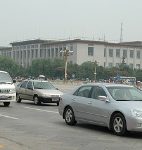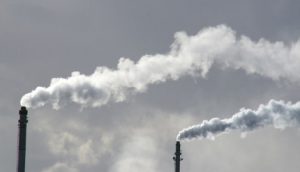After years of neglect, the environment is gradually gaining more attention from China’s leaders. The most noticeable manifestation of this is in their vocabulary.
Six months ago, Hu Jintao, speaking at the opening of a study session for provincial and ministry-level cadres, spoke at unusual length about the “ecological civilisation”, a concept he first put forward in 2007.
Most recently, he has said that, “the construction of an ecological civilisation will be given a prominent place and included in all aspects and processes in economic, political, cultural and social development.”
Read also: Eight major challenges facing China's new leaders
With this, Party rhetoric on environmental matters reached a new peak. And, if we look back at how the Communist Party has talked about environmental protection since 1949, we can see how much its stance has changed.
The government’s first environmental slogan appeared at China’s first environmental protection conference. It called for overall and rational planning, reduction of harm, a reliance on the masses and both the protection of the environment and the enriching of the people. A year earlier, China had sent a delegation to the United Nations Conference on the Human Environment in Stockholm in 1972, at which the Chinese government had no choice but to face up to the problem of pollution.
Back in the early 1960s, none of these concepts were known in China. One senior Party figure recalls Chairman Mao saying that in the future the view from Tiananmen Square would be “all chimneys”.
In the 1990s, the key phrase was “sustainable development”. In 1996, the 9th Five Year Plan for economic and social development was published, along with an outline of long-term targets through to 2010, with sustainable development confirmed as a national development strategy. In 1997, the National Sustainable Development Report was published.
The first appearance of the word “environment” in a national congress report was in 1997, at the 15th Party Congress. The “huge environmental and resource pressures caused by population growth and economic development” was listed as a major difficulty for the nation’s future.
In comparison, the official lexicon on environmental protection is now much broader. In the government’s published reports and documents, in streetside banners and posters, and in speeches by officials, words such as the circular economy, green GDP, the “two-orientated” (resource-conserving and environmentally-friendly) society and energy-saving and emissions-reduction are now commonplace.
China as the factory of the world
In 2001, China joined the World Trade Organisation (WTO) and became embedded in the global economy. Local governments, eager for income, opened their arms to power-hungry, polluting and emissions-heavy industries. As the “factory of the world”, China quickly became the biggest manufacturer in many sectors: concrete, iron and steel, textiles and clothing; then, in more recent years, automobiles, mobile phones and more. But both the Chinese government and the people, having just tasted a better life, were caught unawares by widespread pollution issues.
At the 16th Party Congress in 2003, president Jiang Zemin was already speaking of environmental and resource concerns. He said that in building a xiaokang – a well-off – society, the “conflicts between the environment, natural resources and economic and social development are becoming more apparent daily.” And so one of the targets for building the xiaokang society should be “continual strengthening of sustainable development ability, improvement of the environment, clear increases in resource efficiency, the promotion of harmony between humanity and nature and putting society as a whole onto a development path of production, wealth and environmental-friendliness.”
This led to the “circular economy”. Two years later, China initiated its first wave of circular economy trials in 10 different provinces. Five years later, it passed the Circular Economy Promotion Law.
But it was hard to work against established interests. Sun Zhen, deputy director of the Climate Change Department at the National Reform and Development Commission, China's top economic planning body, said: “it’s difficult to have the economy fix everything. Measures for evaluating officials are a big problem, as they still rely entirely on success in economic development.”
After the 16th Party Congress, public discontent over environmental issues, built up over many years, started to make itself known, with inadequate separation of industrial and residential areas during urbanisation worsening the situation. Yang Hufei, formerly chief engineer at the Ministry of Environmental Protection, has told the media that since 1996, the number of public protests over environmental issues has increased 29% every year.
A short life for “Green GDP”
In 2003, the new premier, Wen Jiabao, put forward the “scientific view of development,” along with the new idea of “green GDP”. But it was a short-lived idea, disappearing before ever making it into high-level vocabulary.
At the fifth plenary session of the 16th Party Congress, in 2005, premier Wen Jiabao put forward the “two-oriented” society – one that conserves resources and is environmentally friendly, pointing the direction for local development. The central government also provided support for trial reforms towards that goal.
“Building an ecological civilisation” was first confirmed in 2007, at the 17th Party Congress. Hu Jintao stressed the four basic goals of the xiaokang society: Chinese-style socialist economic development, political development, cultural development and social development. But the four goals came with five comments – one for each goal, plus “building an ecological civilisation.”
But at the time it was “power-saving and emissions-reduction” that had the most impact on a rapidly industrialising China. In 2006, the government set tough targets for energy intensity and emissions of pollutants. As the 2010 deadline approached, businesses and local government who had failed in their tasks faced sanction – leading to a spate of enforced blackouts. Some firms shut down for two weeks out of four, while hospitals, schools and traffic lights had their power cut off. In one case, a hospital was forced to use generators in order to carry out operations.
This all shows that the problems of economic development can no longer be hidden. Top-level policy must be more strongly enforced if we are to meet the varied pressures facing us. Domestically, the environmental, resource and social costs of our development model are rapidly rising. Internationally, there is pressure to respond to climate change and cut pollution. No matter how you look at it, there is no turning back.
Hu Jintao’s talk of building an ecological civilisation at the recent 18th Party Congress put environmental issues higher up the agenda than ever before. Early this year, the NDRC and MEP investigated progress on the ecological civilisation in more than 10 provinces. By August, there were 53 trial projects under way. But what drew most attention were Hu's words: “Resource consumption, environmental damage and ecological efficiency shall be included in systems for evaluating economic and social development, in order to establish a system of targets, evaluation and rewards and punishments that reflects the requirements of an ecological civilisation.”
With the ecological civilisation shaking up the existing mechanisms for evaluating official performance, the 18th Party Congress has shown the determination of China’s high-level leaders.




